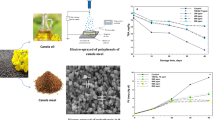Abstract
The aim of this study was to optimize the encapsulation of flaxseed oil within a gelatin-gum Arabic (GA) matrix via complex coacervation. The effect of homogenization rates (3,000–15,000 rpm) and total biopolymer concentrations (1–2% w/v) on emulsion efficiency was studied in order to optimize the wall matrix. The physicochemical properties of the dried powder, and the capsule’s ability to inhibit oxidation during storage were assessed. As homogenization rates increased from 3,000 to 9,000 rpm, the structure of the capsule transitioned from a spherical mononuclear-type to irregular-shaped multinuclear capsules. The size of the capsules and amount of non-encapsulated oil was found to increase as the total biopolymer concentration was raised from 1 to 2% (w/v). Subsequently, gelatin-GA capsules were produced with a 1:1 core-to-wall ratio at a total biopolymer concentration of 2% (w/v) and at a homogenization rate of 9,000 rpm. Formed capsules had an encapsulation efficiency of 84% and showed a protective effect against the production of primary and secondary oxidative products versus non-encapsulated oil during 25 days of room temperature storage.



Similar content being viewed by others
References
Shadhidi F, Miraliakbari H (2005) Omega-3 fatty acids in health and disease: part 2–health effects of omega-3 fatty acids in autoimmune diseases, mental health, and gene expression. J Med Food 8:133–148
Kamal-Eldin A, Yanishlieva NV (2002) N-3 fatty acids for human nutrition: stability considerations. Eur J Lipid Sci Technol 104:825–836
Kaushik V, Roos YH (2007) Limonene encapsulation in freeze-drying of gum arabic-sucrose-gelatin systems. LWT–Food Sci Technol 40:1381–1391
Moghadasian MM (2008) Advances in dietary enrichment with n-3 fatty acids. Crit Rev Food Sci Nutr 48:402–410
Yeo Y, Bella E, Firestone W, Langer R, Kohane DS (2005) Complex coacervates for thermally sensitivity controlled release of flavor compounds. J Agric Food Chem 53:7518–7525
Dong ZJ, Toure A, Jia CS, Zhang XM, Xu SY (2007) Effect of processing parameters on the formation of spherical multinuclear microcapsules encapsulating peppermint oil by coacervation. J Microencapsul 24:634–646
Dong ZJ, **a SQ, Hua S, Hayat K, Zhang XM, Xu SY (2008) Optimization of cross-linking parameters during production of transglutaminase-harden spherical multinuclear microcapsules by complex coacervation. Colloids Surf B Biointerfaces 63:41–47
Chang CP, Leung TK, Lin SM, Hsu CC (2006) Release properties of gelatin-gum arabic microcapsules containing camphor oil with added polystyrene. Colloids Surf B Biointerfaces 50:136–140
Prata AS, Zanin MHA, Ré MI, Grosso CRF (2008) Release properties of chemical and enzymatic crosslinked gelatin-gum arabic microparticles containing a fluorescent probe plus vetiver essential oil. Colloids Surf B Biointerfaces 67:171–178
Song JK, Kang HC, Kim KS, Chin IJ (2007) Microcapsules by complex coacervation of electronic ink. Mol Cryst Liq Cryst 464:845–851
Onder E, Sarier N, Cimen E (2008) Encapsulation of phase change materials by complex coacervation to improve thermal performances of woven fabrics. Themochimica Acta 467:63–72
Nickerson MT, Paulson AT, Wagar E, Farnworth R, Hodge SM, Rousseau D (2006) Some physical properties of crosslinked gelatin-maltodextrin hydrogels. Food Hydrocolloids 20:1072–1079
Dror Y, Cohen Y, Yerushalmi-Rozen R (2006) Structure of gum arabic in aqueous solution. J Polym Sci Part B: Polym Phys 44:3265–3271
AOCS (2003) Official method of analysis, 17th edn. Association of Official Analytical Chemists, VA
Klaypradit W, Huang YW (2008) Fish oil encapsulation with chitosan using ultrasonic atomizer. LWT–Food Sci Technol 41:1133–1139
Heinzelmann K, Franke K, Velasco J, Marquez-Ruiz G (2000) Microencapsulation of fish oil by freeze-drying techniques and influence of process parameters on oxidative stability during storage. Eur Food Res Technol 211:234–239
Soottitantawat A, Takayama K, Okamura K, Muranaka D, Yoshii H, Furuta T, Ohkawara M, Linko P (2005) Microencapsulation of l-menthol by spray drying and its release characteristics. Inn Food Sci Emerging Technol 6:163–170
Pegg R (2005) Measurement of primary lipid oxidation products. In: Wrolstad RE, Acree TE, Decker EA (eds) Handbook of food analytical chemistry. Wiley, New Jersey, pp 515–564
AOCS (2009) Official methods and recommended practices of the AOCS. AOCS Press, Illinois (Methods Cd 18–90, Ti 1a–64)
AOCS (2003) Official Methods and Recommended Practices of the AOCS. AOCS Press, Illinois (Method Cd 8–53)
Bylaitë E, Venskutonis RP, Mapdpieriene R (2001) Properties of caraway (Carum carvi L.) essential oil encapsulated into milk protein-based matrices. Eur Food Res Technol 212:661–670
Barbosa MIMJ, Borsarelli CD, Mercadante AZ (2005) Light stability of spray-dried bixin encapsulated with different edible polysaccharide preparations. Food Res Int 38:989–994
Wrolstad RE, Acree TE, Decker EA, Penner MH, Reid DS, Schwartz SJ, Shoemaker CF, Smith D, Sporns P (2005) Handbook of food analytical chemistry–water, proteins, enzymes, lipids, and carbohydrates, vol 1. Wiley, NJ, pp 513–565
Kolanowski W, Ziolkowski M, Weißbrodt J, Kunz B, Laufenberg G (2006) Microencapsulation of fish oil by spray drying-impact on oxidative stability. Part 1. Eur Food Res Technol 222:336–342
Turchiuli C, Fuchs M, Bohlin M, Cuvelier ME, Ordonnaud C, Peyrat-Maillard MN, Dumoulin E (2005) Oil encapsulation by spray drying and fluidized bed agglomeration. Inn Food Sci Emerging Technol 6:29–35
Acknowledgments
Financial assistance for this study was provided by the Saskatchewan Agriculture Development Fund, the Saskatchewan Ministry of Agriculture Strategic Research Chair Program and the Advanced Foods and Materials Network (AFMNet).
Author information
Authors and Affiliations
Corresponding author
About this article
Cite this article
Liu, S., Low, N.H. & Nickerson, M.T. Entrapment of Flaxseed Oil Within Gelatin-Gum Arabic Capsules. J Am Oil Chem Soc 87, 809–815 (2010). https://doi.org/10.1007/s11746-010-1560-7
Received:
Revised:
Accepted:
Published:
Issue Date:
DOI: https://doi.org/10.1007/s11746-010-1560-7




